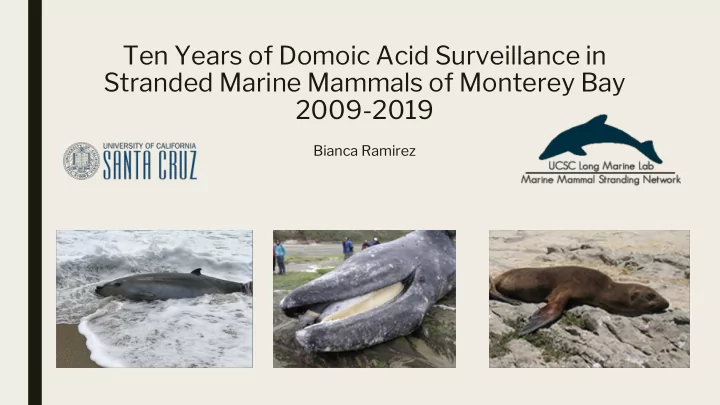

Ten Years of Domoic Acid Surveillance in Stranded Marine Mammals of Monterey Bay 2009-2019 Bianca Ramirez
Introduction and Background The Long Marine Lab Marine Mammal Stranding Network has ■ responded to stranded marine mammals for over 30 years in Pseudo-nitzschia Central California. 200-250 marine mammals strand per year in Monterey and Santa Cruz ■ counties. Pseudo-nitzschia australis is one species of diatom that produces domoic ■ acid (DA) and is associated with harmful algal blooms (HAB) on the central coast Domoic acid is a neurotoxin and has caused unusual stranding and mortality ■ events in marine mammals since at least 1991 in Central California (Scholin et al., 2000) Most work on DA focused on live stranded and rehabilitated marine ■ mammals, clinical effects, and often single species.
Objectives To quantify background levels of domoic acid in stranded marine mammals ■ regardless of the cause of death. To develop a rigorous rubric for assigning cause of death (COD) in dead ■ stranded marine mammals. Approach Collected stomach contents, feces, and urine from all fresh dead stranded ■ marine mammals over a ten year period. Tested for domoic acid and quantified temporal patterns as well as patterns ■ across species Developed cause of death criteria based on literature, did preliminary analysis ■ of DA levels across COD categories
Methodology and Strategy Objective 1 152 animals fresh dead (code 2) or ■ moderately decomposed (code 3) were collected by volunteers and staff – Level-A forms were filled out at the stranding site – Carcasses collected or necropsied fresh Feces, urine, stomach contents were ■ collected and analyzed for DA Objective 2 Criteria for determining COD were ■ developed from the literature and surveying the last ten years of necropsy records Necropsy reports were reviewed by two ■ independent reviewers and assigned a COD
Results & Discussion: DA levels ranged: 0 to 238412.48 ng g -1 ■ Objective 1 75.7% of animals had DA present in at ■ least one sample DA Presence in Stranded Animals in Central Coast 2009-2019 11 of the 13 species collected tested ■ DA Not Present positive for DA. 80 50% of our study set were California Sea ■ DA Present 70 24.3% Number of Animals Lions 60 78.9% of CSLs were positive for DA ■ 50 – Only group to have individuals die 40 from Domoic Acid Toxicity 30 75.7% 20 10 0 Even outside of a known HAB event, n l l l l e n n n n n e e a a a a s l l o i i i i i e a e e e h h h h h a i i S S S S o h h L p p p p p p l l W W l l l background levels of DA in central coast t r r a r o o o o o r u n o u e D D D o D D d k F a b F S P h e c r e d d o d e n a p a a r s k e e s e p H r b i o a e o k d s n e k u e p l b h n a i i a marine mammals is very high. r E l S R B r m o a e e t e a r b f d l b o H e s u i t a t - - l t H N b a o g i t u r h b C B n o G W u o h H L S c i f i c a P Species
Results & Discussion: Preliminary work on COD indicates that there is ■ no correlation between COD and DA levels. Objective 2 Even animals that were killed by human ■ interaction or interspecific trauma had high DA levels. DA Presence in Trauma vs. Non-Trauma Cause of Deaths These data indicate that background levels DA Not Present 140 of DA are likely present in most animals DA Present rather than just sick or injured animals. 120 Number of Animals 100 Future work: ■ 80 – Further refine of the COD rubric – Is there seasonality of acute and chronic DA 60 exposure? 40 – Brain analysis to identify chronic vs. acute DA exposure in all fresh dead animals 20 0 Trauma Non-Trauma
Acknowledgements and References Huge thank you to LML Marine Mammal Stranding Volunteers and Stranding ■ Techs (Karolina Wirga, Amber Diluzio, Gavin Houghton) – To my advisor, Robin Dunkin, this project couldn’t have been done without you! – Dr. Raphael Kudela and Kendra Negrey for DA sample analysis – John H. Prescott Program (grants NA19NMF4390159, NA18NMF4390057, NA17NMF4390093, NA15NMF4390035) Scholin, C. A., Gulland, F., Doucette, G. J., Benson, S., Busman, M., Chavez, F. ■ P., … Van Dolah, F. M. (2000). Mortality of sea lions along the central California coast linked to a toxic diatom bloom. Nature , 403 (6765), 80–84. https://doi.org/10.1038/47481
Recommend
More recommend